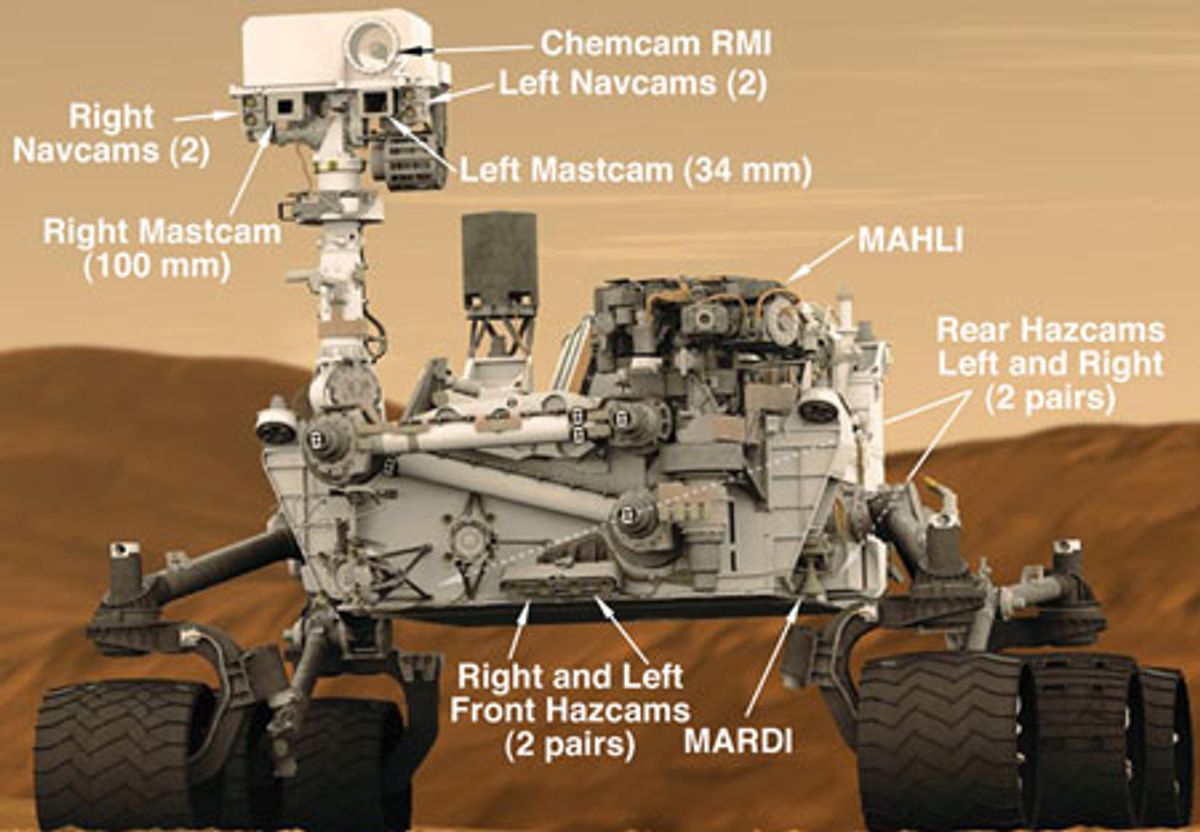After Curiosity successfully lands on Mars, the first thing everybody (including us) is going to want to know is when we'll get the first pictures back from the surface. Curiosity has a whole bunch of cameras, ranging from small hazard avoidance cameras on her body up to HD cameras on her mast, but in the first few hours and days communications will be limited. We'll tell you what you can expect to see first, and the general schedule for image releases going forward.
Earlier, we discussed the importance that the Mars Odyssey orbiter is going to play as a data relay between MSL and Earth. This is true for the entire entry, descent, and landing (EDL), and beyond as well: getting back images as early as possible depends entirely on Odyssey, and we won't know until about 15 minutes before the beginning of EDL whether or not Odyssey was successfully able to position itself to fulfill this role, but JPL seems fairly confident that everything will work out.
Just a few minutes after landing, Curiosity will take a picture with her rear fisheye hazard avoidance camera. This will be the first surface picture taken by the rover. The hazard cameras are equipped with clear dust covers to protect them from debris kicked up during landing, and this first image will be acquired with the dust cover on. So, it may be blurry and/or dusty. It's also going to be very small: the hazcams natively acquire at 1,024 x 1,024 pixels in black and white, but we're only initially going to get a compressed 64 x 64 pixel thumbnail. Within four minutes after landing, the image will be compressed and ready for upload to Odyssey for relay back to us on Earth. When we get it back, it'll look something like this:
That's full-size. Yeah, not exactly spectacular, but as Doug McCuistion (NASA's Mars Exploration Program Director) explained it, "what it'll tell us is, there's ground there so we are actually on the ground, and we got to the planet we wanted to get to." Yay!
Now, you should probably not expect to see this image right away. Even though it'll be ready for transmission only four minutes after landing, Odyssey may have passed overhead and be out of range by that time. According to JPL, we'll be "lucky" to get the rear hazcam image so quickly.
What's more likely to happen is that we'll get our first pictures back approximately two hours later, sometime after 12:30AM PST. This is when Odyssey will have circled all the way around Mars and come back over the landing site, giving Curiosity a second opportunity to relay data to Earth. During this second pass, we can expect to see the rear hazcam image (possibly a larger version, up to 512 x 512 pixels), as well as a front hazcam image, which will be taken with the dust cover removed. Realistically, these are the first images we can expect to see, at 12:30AM PST on Monday.
The next images to be transmitted will come from MARDI, the Mars Descent Imager (above). MARDI will be taking 1,600 x 1,200 pixel color images looking straight down at five frames per second during the descent phase between the separation of the heat shield and touchdown. As with the hazcam images, we're likely to just get thumbnails at first (192 x 144 pixels). The MARDI pics should be coming back at some point on Monday, and it's possible that we'll also get one full resolution MARDI image.
The reason that JPL is going in this sequence (as opposed to just snapping a nice big color picture straightaway) is because the camera that takes the nice big color pics is located on the rover's mast, which will be in a stowed position upon landing. Before JPL has Curiosity raise her mast (and change her center of gravity), they want to be sure that she's not (say) perched on the edge of a cliff or something.
The first picture that we'll get of Curiosity's view of her surroundings will come from MAHLI, a camera on her arm that doubles as a microscope. The arm will be stowed at this point, but MAHLI will be pointing outwards and sideways, giving us at least one good view of the landing site. This image is expected on Tuesday morning.
After that, if everything is safe, Curiosity should be allowed to deploy her mast, arm, and (most importantly) high-gain antenna, significantly increasing the amount of data (i.e. pics) that can be sent back to us while still relying on Mars Odyssey and Mars Reconnaissance Orbiter as relays. Within three days after landing, we'll start seeing images from navigation cameras and the mast cameras, and after about a week, we should have our first high-resolution panorama.
There's one other landing image that we're very much looking forward to. Mars Reconnaissance Orbiter is going to attempt to take a picture of MSL as it lands, using its HiRISE camera. This has been done before, with the Phoenix lander:
Needless to say, this is a very tricky thing to pull off, and the chances of success are probably about 60%. The HiRISE team says that they expect this image to get back to them for processing early Monday morning.
We should reiterate that most of this depends on everything going well, and there's all kinds of ways in which this schedule could change. We'll keep you updated throughout the night as we get more information.
[ MSL ]
Evan Ackerman is a senior editor at IEEE Spectrum. Since 2007, he has written over 6,000 articles on robotics and technology. He has a degree in Martian geology and is excellent at playing bagpipes.








